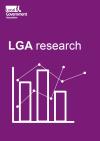he data extracted from the NCMP data collection for this analysis included the following:
- Prevalence of both overweight and obesity among Reception children
- Prevalence of obesity among Reception children
- Prevalence of both overweight and obesity among Year 6 children
- Prevalence of obesity among Year 6 children.
The above statistics were extracted for all English single tier and county councils (that is, all English principal authorities excluding district councils), and for England as a whole. The local authorities of the City of London and the Isles of Scilly were not present in the data, due to having unusually small populations and often forming outliers compared to all other local authorities.
In some cases, local authorities or their boundaries changed during or after the seven-year period for which data was extracted. The measures taken to adjust for those changes was as follows:
Bournemouth, Christchurch and Poole Council: replaced Bournemouth and Poole unitaries and part of Dorset County Council on 1 April 2019, with the earliest available figures for the new council starting with 2019/20. The previous prevalence figures for Bournemouth Council have been used for academic years preceding this.
Dorset Council: replaced most of the area previously governed by Dorset County Council on 1 April 2019. As above, the earliest available figures for the new unitary authority start with 2019/20. For the years before this, figures for the previous Dorset County Council have been used.
Buckinghamshire Council: replaced Buckinghamshire County Council on 1 April 2020. All of the NCMP figures extracted relate to the former county council rather than the new unitary council, but as their boundaries are identical these estimates can be used to estimate future obesity prevalence for the unitary authority.
North Northamptonshire and West Northamptonshire Councils: replaced Northamptonshire County Council on 1 April 2021. All NCMP figures extracted relate to the former county council rather than the new unitaries. As such, it is not possible based on this analysis to arrive at individual projections for either of the two new councils, but only for Northamptonshire as a whole.
As a result, whilst there are 152 single-tier and county councils in existence in England, this forecasting approach produced estimates for 149 local authority areas (excluding the Isles of Scilly, City of London, North Northamptonshire and West Northamptonshire, and including one set of projections for the former Northamptonshire County Council).
The time range for which statistics were extracted covered the seven academic years starting from 2013/14 and ending with 2019/20. In a small number of cases 2013/14 figures were not available for some local authorities, and the projections in these cases rely only upon the subsequent six academic years.
In the statistics used, individual pupils were linked to local authorities based on the local authority that submitted their data. An alternative set of statistics was formerly published which aggregated pupils instead to the local authority of their residential postcode, but as of 2019/20 these figures are no longer published.






